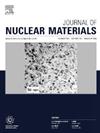International Simple Glass (ISG) dissolution rate in a (Si, Ca)-rich environment at 90 °C and alkaline conditions
IF 2.8
2区 工程技术
Q3 MATERIALS SCIENCE, MULTIDISCIPLINARY
引用次数: 0
Abstract
The dissolution of International Simple Glass (ISG) was investigated at 90 °C and alkaline conditions with various concentrations of dissolved Si and Ca to unravel the combined effects of those elements on ISG reactivity. Experiments were conducted over durations ranging from 20 days to 3 months. Through morphological, structural, and chemical characterizations, the glass dissolution rate was proven to be strongly correlated with the activity of dissolved silica in the solution. While dissolved calcium did not significantly impact the dissolution rate, precipitation of calcium silicate hydrates (CSH) during the experiments enhanced ISG dissolution rate, though to a modest extent. The 3-months experiments highlighted the strong correlation between the dissolution mechanism and the evolution of the nature of secondary phases in saturated solution. During the first 20 days and at high Si and Ca concentrations, CSH precipitated and aggregated, without preventing the passivating impact of the gel layer at the surface of the glass: the dissolution was controlled by diffusion. Then, a resumption of dissolution occurred between 19 days and 76 days, corresponding to the CSH growth, and a possible mechanistic switch to a hydrolysis-controlled reaction rate. Finally, in some experiments, a drop in pH due to carbonate precipitation was observed along with a decrease in the dissolution rate, falling back in a diffusion-limited regime. Overall, this study shows that at 90 °C, pH = 10 and concentrations of SiO2(aq) exceeding 50 % of saturation with respect to amorphous silica, irrespective of Ca concentration but in presence of CO2(aq), ISG exhibits a very good chemical durability.
国际简易玻璃 (ISG) 在 90 °C 和碱性条件下的富含(硅、钙)环境中的溶解率
研究了国际简易玻璃(ISG)在 90 °C 碱性条件下不同浓度的硅和钙的溶解情况,以揭示这些元素对 ISG 反应性的综合影响。实验持续时间从 20 天到 3 个月不等。通过形态、结构和化学特性分析,证明玻璃的溶解速率与溶液中溶解硅的活性密切相关。虽然溶解的钙对溶解速率没有明显影响,但实验过程中硅酸钙水合物(CSH)的沉淀提高了 ISG 的溶解速率,尽管程度不大。为期 3 个月的实验凸显了溶解机制与饱和溶液中次生相性质演变之间的密切联系。在最初的 20 天内,在硅和钙浓度较高的情况下,CSH 会析出并聚集,但不会阻止玻璃表面凝胶体层的钝化作用:溶解是由扩散控制的。然后,溶解在 19 天到 76 天之间恢复,与 CSH 的增长相对应,可能的机理转换为水解控制反应速率。最后,在一些实验中,观察到由于碳酸盐沉淀导致 pH 值下降,同时溶解速率下降,重新回到扩散受限的状态。总之,这项研究表明,在 90 °C、pH = 10 和 SiO2(aq)浓度超过无定形二氧化硅饱和度的 50%的条件下,无论钙浓度如何,只要存在 CO2(aq),ISG 就能表现出非常好的化学耐久性。
本文章由计算机程序翻译,如有差异,请以英文原文为准。
求助全文
约1分钟内获得全文
求助全文
来源期刊

Journal of Nuclear Materials
工程技术-材料科学:综合
CiteScore
5.70
自引率
25.80%
发文量
601
审稿时长
63 days
期刊介绍:
The Journal of Nuclear Materials publishes high quality papers in materials research for nuclear applications, primarily fission reactors, fusion reactors, and similar environments including radiation areas of charged particle accelerators. Both original research and critical review papers covering experimental, theoretical, and computational aspects of either fundamental or applied nature are welcome.
The breadth of the field is such that a wide range of processes and properties in the field of materials science and engineering is of interest to the readership, spanning atom-scale processes, microstructures, thermodynamics, mechanical properties, physical properties, and corrosion, for example.
Topics covered by JNM
Fission reactor materials, including fuels, cladding, core structures, pressure vessels, coolant interactions with materials, moderator and control components, fission product behavior.
Materials aspects of the entire fuel cycle.
Materials aspects of the actinides and their compounds.
Performance of nuclear waste materials; materials aspects of the immobilization of wastes.
Fusion reactor materials, including first walls, blankets, insulators and magnets.
Neutron and charged particle radiation effects in materials, including defects, transmutations, microstructures, phase changes and macroscopic properties.
Interaction of plasmas, ion beams, electron beams and electromagnetic radiation with materials relevant to nuclear systems.
 求助内容:
求助内容: 应助结果提醒方式:
应助结果提醒方式:


